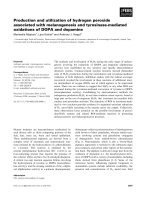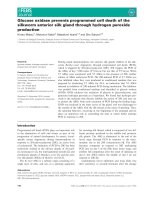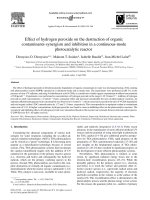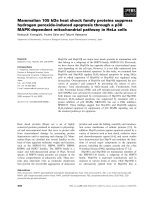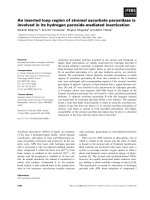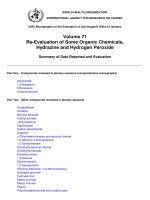Hydrogen peroxide medical miracle
Bạn đang xem bản rút gọn của tài liệu. Xem và tải ngay bản đầy đủ của tài liệu tại đây (1.17 MB, 180 trang )
i
HYDROGEN PEROXIDE
Medical
Miracle
William Campbell Douglass, MD
Rhino Publishing, S.A.
www.pdfgrip.com
ii
H YDROGEN P EROXIDE –M EDICAL M IRACLE
Medical
Miracle
Copyright © 1990, 1992, 1995, 1996, 2003
by
William Campbell Douglass, MD
All rights reserved. Unauthorized reproduction of this
book or its contents by xerography, facsimile, or any other
means is illegal, except for brief quotations in reviews or
articles.
ISBN 9962-636-25-6
Cover illustration by
Alex Manyoma ()
Please, visit Rhino’s website for other publications from
Dr. William Campbell Douglass
www.rhinopublish.com
Dr. Douglass’ “Real Health” alternative medical
newsletter is available at www.realhealthnews.com
RHINO PUBLISHING, S.A.
World Trade Center
Panama, Republic of Panama
Voicemail/Fax
International: + 416-352-5126
North America: 888-317-6767
www.pdfgrip.com
1
Dedication
To Charles H. Farr, M.D., Ph. D.,
to whom the world owes a great debt.
www.pdfgrip.com
2
H YDROGEN PEROXIDE –M EDICAL M IRACLE
Contents
Foreword .................................................................................
3
Introduction ............................................................................
5
Chapter 1
The Roots of a Remarkable Therapy .................................
9
Chapter 2
It Really Works – But How? ................................................ 15
Chapter 3
The Research Proves It ......................................................... 23
Chapter 4
Criticisms of Hydrogen Peroxide Therapy ..................... 33
Chapter 5
The Farr Experiments ........................................................... 41
Chapter 6
Throw Out Your Toothpaste ............................................... 55
Chapter 7
Some Random Tidbits on H 2O 2 ........................................................................... 63
Chapter 8
Some Impressive Case Histories ........................................ 75
Chapter 9
Peroxide Therapy, Africa, and AIDS ................................. 111
Chapter 10
Some Questions and Answers ............................................ 133
Appendix I
International Oxidative
Medicine Association (IOMA) ............................................ 141
Appendix II
Therapeutic Uses of H2O2 147
Appendix III
Metabolic and Physiological
Effects of Peroxide Healing ................................................. 151
Notes ........................................................................................ 155
Bibliography ........................................................................... 159
Index ......................................................................................... 173
www.pdfgrip.com
3
Foreword
W
hat's going on here? Peroxides are supposed
to be bad for you. Free radicals and all that.
But now we hear that hydrogen peroxide is
good for us.
I have been very skeptical about this one, but so
many patients were asking my opinion about H2O2 that it
was getting embarrassing to say, "I don't know." I didn't
want to give up Monday Night Football to research H2O2
, but there was just no way out of it. (The games were
lousy anyway.)
I was astounded to find that excellent clinical research had been done on the medical uses of hydrogen
peroxide as far back as 1914! (There goes my Monday
Night Football—maybe Sunday afternoon, too.)
Doctor J.S. Haldone reported in 1919 that oxygen dissolved in the blood would probably be a good way to
combat infection. (Remember that in those days infection
was it. If you didn't get stomped to death by a horse, you
would most likely die of infection. Cancer was not a
scourge and cardiovascular disease had not been invented yet.)
Hydrogen peroxide will put extra oxygen in your
blood. There's no doubt about that. But prevailing expert
opinion is that it has no value. The red cells must transport oxygen for effective oxygen delivery, they tell us. But
this is manifestly untrue. Hyperbaric oxygen therapy, for
instance, where oxygen is forced into the blood under pressure, can be lifesaving in carbon monoxide poisoning, cyanide poisoning, and smoke inhalation.
www.pdfgrip.com
4
H YDROGEN PEROXIDE –M EDICAL M IRACLE
But pushing oxygen into the blood by using pressure
is an expensive business. A hyperbaric oxygen unit costs
about $100,000. Hydrogen peroxide costs pennies. So if
you can get oxygen into the blood cheaply and safely,
maybe cancer (which doesn't like oxygen), emphysema,
AIDS, and many other terrible diseases can be treated effectively.
Intravenous hydrogen peroxide rapidly relieves allergic reactions, influenza symptoms, and acute viral infections. These effects are thought to be due to the oxidation
of the various foreign substances in the blood.
Tumor cells, bacteria, and other unwanted foreign elements in the blood can usually be destroyed with hydrogen peroxide treatment. Peroxide has a definite
destructive effect on tumors, and, in fact, cancer therapy
may prove to be the most dramatic and useful place for
peroxide therapy.1
No one expects to live forever. But we would all like
to have a George Burns finish. The prospect of finishing
life in a nursing home after abandoning your tricycle in
the mobile home park is not appealing. Then comes the
loss of control of vital functions—the ultimate humiliation. Is life supposed to be from tricycle to tricycle and
diaper to diaper? You come into this world crying, but do
you have to leave crying? I don't believe you do. And you
won't either after you see the evidence.
Sounds too good to be true, doesn't it? Read on and
decide for yourself.
William Campbell Douglass, M.D.
www.pdfgrip.com
5
Introduction
H
ydrogen Peroxide, peroxide, and H 2 O 2 are
terms which "will be used interchangeably
throughout this book.
We are going to start with some quotes from a doctor
of medicine, Peter Gott, M.D. He is passionately and irrevocably dedicated to the practice (and science) of medicine as it is defined (and enforced) by the great fountain
of knowledge represented by the Mayo Clinic, Harvard,
The P.N.EJ.M. (The Prestigious New England Journal of
Medicine), and the American Medical Association (AMA).
Dr. Gott attacks viciously and acerbically anything
that he perceives to be heretical, while ignoring the basic
research and clinical research that has appeared in his own
revered conventional scientific literature.
It's what I call scientific scotomata. Scotomata are blind
spots in the visual field. On a test screen used by an eye
doctor, these will be black blobs in various parts of the
field of vision. There are many causes for this eye disease.
The scotomata of the intellect seen in many scientists, especially medical scientists, is not a physical but an intellectual affliction.
We are taught in medical school, in subtle ways, that
you can't trust any research findings that don't have the
blessing of the temples of learning and bastions of the status quo mentioned above, even if that research was done in a
respected center by a respected researcher. Look at the way
they drove Dr. George Crile out of the Temple of Medicine for reporting, after years of careful research, that
radical breast cancer surgery is a waste of time. His research was done at the Cleveland Clinic. Doctor Linus
www.pdfgrip.com
6
H YDROGEN PEROXIDE –M EDICAL M IRACLE
Pauling, a Nobel prize winner, got the same treatment for
his work on vitamin C and cancer.
Doctor Gott writes a syndicated column in which he
attacks anything in medicine that he considers to be heresy. One of his recent attacks was on hydrogen peroxide,
the subject of this book. Doctor Gott has apparently, from
the content of his remarks, had no experience with H2O2
beyond the bleaching of hair. He says that hydrogen peroxide is for external use only and especially for women
who are convinced that blondes have more fun.
Dr. Gott knows that he is right because he is a doctor
who embraces scientific methods—like calling peroxide
therapy knavery—without having bothered to research
the scientific literature. Gott is in for a surprise—if he ever
does his homework.
In one of his sarcastic articles1 he lists what I call ha ha
items to show his contempt for some of the claims made
by researchers associated with hydrogen peroxide:
Micro-organisms give off calcium waste matter that
cements bones together—ha ha.
They lodge in liver and kidneys—ha ha.
And they line the arteries causing hard deposits on
the arterial walls—ha ha.
Gott is apparently too convulsed with laughter to tell
you that the basic research from which these claims were
derived was done by Dr. Edward C. Rosenow, author of
450 published medical papers and an associate at the
Mayo Clinic for over 60 years! (Ha Ha). Dr. Rosenow
proved over 80 years ago (1914) that bacteria could be
found consistently in the lymph nodes that drain joints.2
He was probably the first scientist to postulate that H2O2
would help arthritis because of its ability to supply oxygen to oxygen-hating organisms causing arthritis (streptococcus viridans).
I have reviewed the scientific literature of the past
176 years on hydrogen peroxide; hundreds of articles on
such subjects as: "Catalysis of single oxygen production in
the reaction of hydrogen peroxide and hypochlorous acid
by diazabicyclo octane."
www.pdfgrip.com
7
Introduction
Can you imagine how boring it is to wade through
that kind of sanskrit to get to the good stuff? (I hope you
show your appreciation by buying a lot of these books.)
Walter Grotz, one of the pioneers in oral peroxide
therapy, has a keen and inquisitive mind. Although he is
an ex-bureaucrat himself (retired postmaster), he understands and dislikes bureaucracy like most of the rest of
us. And Mr. Grotz understands something else that many
don't understand. All of the bureaucracy and self-serving
bureaucrats are not in the government.
Take the American Cancer Society, for instance. Grotz
took peroxide by mouth, and in 16 days his arthritis had
improved dramatically. He called the American Cancer
Society and asked their opinion of hydrogen peroxide
therapy. The representative who answered the phone said
it was quackery.
"You mean a therapy that costs a lot of money and
doesn't do any good?" he asked. "Yes," she replied, "that's
the best explanation I have heard. It costs a lot of money
and doesn't do any good."
His treatment cost less than six dollars.
Walter Grotz discovered something else that dispels a
myth about H2O2 . Ask the average scientist if he would
expect to find any oxygen left after boiling and distilling
hydrogen peroxide. He would probably say no, because
H2O2 has a boiling point of 152 degrees Fahrenheit. You
don't have to heat it much to make it boil. But, surprisingly, after distilling there is still considerable oxygen left
in the fluid. It's a quirk of nature. Undoubtedly, there is a
scientific explanation, but I don't know what it is.
There are a number of products on the market that
claim to supply oxygen to the body better and more
safely than H2O2 . These products (Aerox, Di-Oxychloride,
Anti-Oxid-10, and others) are simply a very expensive
method of doing what H2O2 will do for pennies.
A comparison of peroxide with these little bottles reveals that hydrogen peroxide contains 94 percent oxygen.
The dropper bottles contain 47 percent oxygen, which
comes from chlorine peroxide.
www.pdfgrip.com
8
H YDROGEN PEROXIDE –M EDICAL M IRACLE
The peroxide, which is dirt cheap, breaks down into
water and oxygen. The chlorine peroxide breaks down
into chlorine and oxygen. So at equal volumes, you get
twice as much oxygen from peroxide and no chlorine
(which you don't need, although it does no harm in such
small quantities).
So you are actually paying $40 an ounce for your oxygen in these products. (They cost $20 an ounce, and up,
but are less than 50 percent oxygen.) Peroxide can be obtained for $.40 a pint. Take your choice.
www.pdfgrip.com
9
Chapter 1
The Roots of a RemarkabIe
Therapy
T
he Indians (as in India) have been fascinated
by oxygen as a therapy for a long time. Back in
1940, Doctors Inderjit Singh and Mangaldas
Shah of Bombay, India experimented on oxygen given intravenously.1
But the concept goes back even further. O2 therapy
was discussed in the Lancet for the first time in 1916.
Drs. Turnicliffe and Stebbing noted in their Lancet article2 that Nysten had used O2 successfully in dogs in
France in 1811: "The animal seemed entirely unaffected
by the injections" (i.e., no side effects).
They also pointed out that Doctor Demarquay, in
1886, made the observation that the oxygen given was not
completely eliminated by the lungs and, therefore, went
to the tissues.3 He made this simple and very astute observation by cutting the animal and noting that the blood
was bright red, rather than the usual dark red of the venous blood. This observation was recently confirmed
with modern, precise instruments.
With these encouraging reports from the old French
literature, Turnicliffe and Stebbing in England tried pure
oxygen intravenously for the first time in humans in 1916.
Their conclusions from their experiments were unequivocal: The intravenous method of oxygen administration,
if carefully carried out ... is available to the clinician and will
give therapeutic results.
Doctors being doctors, they became victims of the
"Tomato Effect." Everyone, including "scientific authori-
www.pdfgrip.com
10
H YDROGEN PEROXIDE –M EDICAL M IRACLE
ties" in the 18th century, knew that tomatoes were poisonous. So, today, "everyone knows" that hydrogen peroxide
cannot be used as a therapeutic agent. If this were not so,
we would have read about it in the Journal of the American
Medical Association (JAMA). A quick look at a copy of the
JAMA will tell you why doctors don't know about peroxide "bio-oxidative" therapy. Drug companies, through
their advertising, foot the bill for the journal. Cheap peroxide therapy would put many of them out of business.
Our Indian friend, Doctor Singh, attempted in 1932 to
give oxygen under the skin and into the abdominal cavity. He found that the amount absorbed was too small to
be of practical value. The first recorded use of peroxide in
this country was by a Georgia doctor located, I'm proud
to say, a short walk from my former office. In 1888, Dr. P.L
Cortelyou of Marietta, Georgia, reported on the use of
peroxide in treatment of diseases of the nose and throat.
In one case of diphtheria, often fatal in those days, he
used a nasal spray of peroxide, and the patient was well
in one day.
Many other attempts at oxygen therapy were made
between 1811 and 1935. But researchers lost interest with
the advent of the drug era in medicine, starting around
1940.
Intravenous oxygen therapy isn't the only promising
line of research that was dropped with the advent of the
pharmaceutical revolution. Homeopathy, herbology,
electro-medicine, and a lot of other promising lines of research were thrown out. Drugs were in. That's where the
research money was (and is). Drugs were going to solve
all of our medical problems.
We now know that drugs are not going to solve all of
our problems. Some researchers are going back to basics
and taking up research that never should have been
dropped, like oxygen therapy.
Going back to 1940 and Dr. Singh, the last of the early
pioneers of oxygen therapy, he found that dogs could be
kept alive for 16 minutes on intravenous oxygen—with-
www.pdfgrip.com
The Roots of a Remarkable Therapy
11
out any air going through the lungs. It's usually curtains
within three to five minutes.
He next tried giving oxygen in the vein to patients
dying of pneumonia. Pneumonia was another deadly disease in those days. The antibiotics deserve some credit
here for saving people from death due to pneumonia.
(But they get more credit than they deserve.)
Out of six cases given the intravenous oxygen, five
died. One typical report: "There was distinct clinical improvement, but the patient died after seven days."
Hmmm.
The one in six who lived wasn't as sick as the others.
There was little oxygen research done for the next 20
years. I guess I would have gotten discouraged, too.
A German doctor, H.S. Regelsberger, wrote a book on
the oxygenation of blood for the treatment of high blood
pressure. He theorized that oxygenation would reduce
the viscosity or thickness of blood and thereby reduce
blood pressure. The theory proved to be correct. His
book, Oxygenation, should be required reading for all
medical students. (I've been trying to locate a copy—no
luck.)
Dr. Edward Carl Rosenow's 450 published papers
should also be required reading. But they have disappeared
into the memory hole. It's the strangest thing. I looked him
up in the authors index at the Emory University medical
library. There were no references to any of his peroxide research. A call to the Mayo Clinic was a waste of my
nickel. The girl I talked to didn't know who I was talking
about.
The researchers at Baylor University had their funding cut off, although their findings were sensational. Is
there a conspiracy here? Seems like it to me.
In 1920, Doctors Oliver and Cantab reported to the
Lancet on the use of hydrogen peroxide in a series of
pneumonia cases in India. An 80 percent mortality was
being experienced among Indian troops from pneumonia.
Doctors Oliver and Cantab made a bold move against
this devastating epidemic. They decided to do the un-
www.pdfgrip.com
12
H YDROGEN PEROXIDE –M EDICAL M IRACLE
thinkable—inject hydrogen peroxide directly into the
vein. Textbooks warned that gas embolism, a dreaded
condition causing strokes through bubbles in the brain,
would result from intravenous hydrogen peroxide administration.
The doctors felt they had little to lose. The soldiers
were dropping faster than in a battle with the Gurkas.
They treated only those cases that were considered hopeless. Out of these they saved about 50 percent—13 out of
25 lived. All would have died without hydrogen peroxide. There was none of the dreaded gas embolism or any
other side-effects.
What was the mechanism of these remarkable recoveries from a terminal condition? You'd think that if the
oxygen is stimulating the good cells, then the bugs causing the problem would also be stimulated. What apparently happens is that the toxins formed by the bacteria or
virus are oxidized by the oxygen. (That's just my theory.
I'm open to suggestions.)
They point out that hydrogen peroxide has always
been assumed to be toxic to cells. Boy, were we wrong. It
now appears H2O2 is an essential metabolite. That means
it's not toxic, but essential to life's process. How's that for a
switch? Doctor Rannasarma of the Indian Institute of Science says, "The generation of H2O2 in cellular processes
seems to be purposeful and H2O2 cannot be dismissed as
a mere undesirable by-product."
Another terrible condition that often leads to death,
unless massive antibiotic therapy is combined with hyperbaric oxygen, is gas gangrene, an infection that follows
severe lacerating injury or surgery. 4 The bacteria involved create a gas that invades the tissues. The tissues
swell to enormous size due to the gas formation, and the
most unimaginable smell emanates from the infected tissue. It's literally the smell of death, the smell of the battlefield. If untreated, the victim will die within 48 hours.
Like cancer cells, the bacteria that cause gas gangrene
thrive without oxygen, so the treatment of choice has
www.pdfgrip.com
The Roots of a Remarkable Therapy
13
been massive doses of penicillin combined with hyperbaric oxygen (HBO). But HBO is not readily available,
and probably never will be.
Two Indian doctors in New Delhi, India, experimented on dogs given a gas gangrene infection. The dogs
were injected with two billion gas-forming organisms into
the muscle of a leg. One set of dogs received H2O2 treatment through an artery leading to the infection site. The
other set of dogs got the inoculations of gas gangrene bacteria but no H2O2 .
The dogs not getting the H2O2 developed the usual
stinking, rotten infection with sloughing of skin and muscle. They all eventually died of septicemia. Of the 10 dogs
treated with H2O2 only two developed gas gangrene infection.
Gas gangrene is most commonly seen under wartime
conditions. If medical science would only recognize the
importance of this long-neglected therapy, many battlefield tragedies could be avoided at little cost.
www.pdfgrip.com
14
H YDROGEN PEROXIDE –M EDICAL M IRACLE
www.pdfgrip.com
15
Chapter 2
It Really Works But How?
H
ydrogen peroxide, which properly should be
called "hydrogen dioxide, is a colorless (blue
in thick layers), odorless liquid. Its melting
point is minus two degrees Celsius, and its boiling point
is 152 degrees Celsius. It is soluble in water at all concentrations and it is usually encountered as a dilute solution
of three percent. Hydrogen peroxide is used (1) as a
bleaching agent; (2) as an antiseptic and disinfectant; (3)
as an oxidizing agent, and (4) as an oxidizer in rocket motors for small rockets.
Hydrogen peroxide solutions dismutate (i.e., break
down) slowly when undisturbed at about the rate of one
percent per month. Contrary to popular belief, hydrogen
peroxide is not unstable, and even when heated, it will
break down very slowly. If this dismutation reaction is
rapidly increased in the presence of contaminants such as
dust, metal, or glass, it may be quite explosive. Cold retards the dismutation and solutions may be refrigerated
or stored at temperatures below zero degrees Celsius. Hydrogen peroxide occurs only in traces in nature, mostly in
rain and snow. It has not yet been detected in interstellar
space.1
Early studies on H2O2 infusions predicted that its
half-life is less than one-tenth of a second. However, more
recent studies by MacNaughton calculated that the halflife of peroxide ranges from three-quarters of a second to
two seconds and is dependent upon the rate of mixing in
the blood.
All species of animals do not react the same to peroxide because there are species differences in catalase en-
www.pdfgrip.com
16
H YDROGEN PEROXIDE –M EDICAL M IRACLE
zyme content between man and animal. So the results
from many animal models will not correlate with what
happens in man and, therefore, are not applicable to man.
Dogs and chickens, for instance, have very low catalase
levels, and so they have poor tolerance to H2O2 . In fact,
you can kill them with hydrogen peroxide. They will develop pulmonary edema and methemoglobinemia. However, in man, catalase is abundant in both the plasma and
red cells and is significantly elevated in diseases such as
rheumatoid arthritis.2 It can be used in dogs, as you will
soon see from the reports in this chapter. You just have to
be careful.
Hydrogen peroxide initially reacts with catalase in
the plasma and the white blood cells. Later, it penetrates
the cell membrane of erythrocytes (red blood cells), where
it reacts with catalase within the cell, and additional oxygen is then released.
Some of the biological killing activities of hydrogen
peroxide may be attributed to interferon. Production of
interferon by human killer cells and monocytes is stimulated by hydrogen peroxide.
Studies have been done comparing hyperbaric oxygen (giving the patient oxygen under pressure in a high
pressure tank) and intravenous hydrogen peroxide to
compare the level of the oxygen content in tissues.3 These
researchers found that the tissue oxygen levels with intravenous hydrogen peroxide paralleled the increase in oxygen found with hyperbaric oxygen pressure treatment.
This is a very important finding, because hyperbaric oxygen treatment is expensive, does have some risks, is
rather cumbersome, and is generally not available.
Conversely, intravenous hydrogen peroxide is more
readily available, is relatively cheap, safe, and quite effective. Also of great importance, Dr. Charles Farr found that
increased oxvgen content of tissues often was not recorded until 40 to 45 minutes after the beginning of the
peroxide injection. This probably explains why some investigators did not find a rise in the tissue oxygen pressure, because they measured it too soon. These
www.pdfgrip.com
It Really Works—But How?
17
investigators speculated that any increased venous oxygen saturation in tissues would be lost by diffusion of
oxygen in the pulmonary capillary bed of the lungs. But
Farr found this to be in error.4
If you're not interested in the physiological reasons
why Dr. Farr found previous assumptions to be in error
concerning the amount of oxygen absorbed through intravenous hydrogen peroxide, we suggest you skip the following paragraph:
If oxygen, released from intravenous H2O2 , diffuses
from the pulmonary capillary bed into the alveolar space,
alveolar pO2 will rapidly increase and pulmonary capillary blood pO2 will decrease. Diffusion into the alveoli
will occur more rapidly than the alveolar loss of oxygen
to respiratory exchange. Inspired oxygen added to the
oxygen diffused into the alveoli from the pulmonary capillary at the arterial end would increase the alveolar pO2
greater than the blood pO2 at the venous end of the capillary. The increased pO2 in the alveolus would cause the
oxygen to rapidly diffuse back into the pulmonary capillary at the venous side and go back into systemic circulation. This postulate was confirmed by studies of
pulmonary oxygen uptake to determine metabolic rate in
subjects receiving various concentrations of intravenous
hydrogen peroxide.5
Welcome back.
We have noted, as has Dr. Farr, that blood specimens
taken during and after hydrogen peroxide infusions show
a color change consistent with an increase in oxygen content of the blood after the infusion. We sent a sample to
the laboratory, and, although it was a venous specimen,
the lab reported back that it must have been an arterial
sample because of the high oxygen color of the blood.
After an hour of infusion of hydrogen peroxide, a 210 percent decrease will be noted in many blood constituents—such as sodium, potassium, chloride,
phosphorus, etc. Twenty-four hours later, all of these
constituents of the blood will have returned to normal
pre-infusion levels.
www.pdfgrip.com
18
H YDROGEN PEROXIDE –M EDICAL M IRACLE
***
The clinical benefit of oxygen saturation of tissue
fluid from the oxygen produced by hydrogen peroxide
may be of secondary importance. Very little peroxide is
used in the treatment and, hence, very little oxygen is actually produced. Hydrogen peroxide is a powerful
oxidizer, however, and will oxidize toxic and nontoxic
substances alike, which is completely separate from its
role as an oxygen contributor. Farr describes the biologic
effects observed from the intravenous administration of
H2O2 as "oxidative detoxification." The oxidative benefits
may include the oxidation of lipid material in the vessel
wall to reverse atherosclerosis.6 There are many other
physiological benefits to oxidative detoxification, but it is
too technical for this book. However, if you wish to investigate further, we recommend the article by Weiss, in the
Journal of Clinical Investigation (1981;68:714-721). Weiss discusses things that I'm sure you remember from your high
school biology course, such as aggregated immunoglobins, immune complexes, and bacterial peptides.
Peroxide is the ammunition of your killer cells. Your
body's elite corps of bacterial assassins, called polymorphonuclear leukocytes (PMN's), engulf bacteria then kill
them with the "respiratory burst." The cell combines oxygen and water, making H2O2 . That's the respiratory burst.
The H2O2 then zaps the bacteria.
Those PMN's are really smart. First they identify the
invader. (How do they do that, with no eyes and no
brain?) Then they move to the attack. (No legs, either.)
On contact, they gobble the bacteria and zap it with H2O2 .
Amazing!
If your white cells didn't produce H2O2 , the respiratory burst would not be possible, and bacteria would
have taken over the world a long time ago. So hydrogen
peroxide has been promoted from an ordinary mouthwash to one of life's most important bodyguards. (The
Bird Man of Alcatraz knew what he was talking about.
He was a convict who had a special love for birds. He
would treat a sick bird, who happened onto the island,
www.pdfgrip.com
It Really Works—But How?
19
with hydrogen peroxide and had quite phenomenal results in curing his little patients. Hence his nickname, The
Bird Man of Alcatraz.)
And speaking of mouthwash, don't throw that bottle
of hydrogen peroxide sitting in your medicine cabinet
away. It's still better than Scope, Lavoris, Cepacol, or any
other of those red and green liqueurs peddled on TV. It
kills bacteria, retards gingivitis, and reduces plaque formation. It costs about one-tenth what you'd pay for those
dessert drinks. Studies have shown that Legionnaire's disease,7 syphilis,8 yeast (candida), viruses, and even parasites will respond to hydrogen peroxide.
Hydrogen peroxide seems to be the all-purpose executioner. The Middlesex Hospital Medical School in London experimented with H2O2 in the treatment of malaria,
which is a parasite rather than a bacterium. They found it
to be effective.9
Hydrogen peroxide is truly the wonder molecule.
The cells in your body that fight infection, called
granulocytes, produce H 2O2 as a first line of defense
against every single type of invading organism—parasites, viruses, bacteria, and yeast. No other chemical compound comes
even close to H2O2 in its importance to life on this earth.
H2O2 is involved in all of life's vital processes. Protein,
carbohydrate and fat metabolism, vitamin and mineral
metabolism, immunity, and anything else involving life's
functions require the presence of this amazing molecule.
There are over 6,100 articles in the scientific literature
dating from 1920 on the scientific applications of hydrogen peroxide. It seems inconceivable that the astounding
medical cures reported in science journals over the past
75 years could have been ignored. The reasons for this scientific blindness will become apparent to you as the peroxide story unfolds.
In some mysterious way not yet identified, H2O2 is
involved in phagocytosis, the process by which some
of your blood cells eat enemy bacteria. H2O2 also acts
like insulin, in that it aids the transport of sugar through
the body.
www.pdfgrip.com
20
H YDROGEN PEROXIDE –M EDICAL M IRACLE
Hydrogen peroxide may be just as important, or
more important, than thyroid for heat generation. As you
know, your car won't run properly if it is cold. Neither
will your body. H2O2 , in the presence of coenzyme-Q10,
creates "intracellular thermogenesis," a warming of your
cells which is absolutely essential to life. As one researcher put it, the new information on H2O2 affords the
conceptual basis for a revolution in our thinking about many
of life's vital processes.
It's amazing how medicine has largely ignored this
well-researched and unique therapy. But what's new?
Some doctors still don't wash their hands between patients, although Dr. Ignatz Semilweise proved a hundred
years ago that doctors were the main cause of the spread
of infection in hospitals because of their contaminated
hands. Nothing changes. Peroxide therapy will continue
to be resisted and ridiculed by American doctors.
Most of the work at Baylor University, which we will
discuss in the next chapter, was done by dripping H2O2
into an artery. It really isn't necessary to use the more difficult arterial route for peroxide therapy.
One of our colleagues measured a pulmonary (lung)
patient's arterial pO2 level (the measure of oxygen content), before and after hydrogen peroxide therapy. After
the infusion of hydrogen peroxide, this patient's oxygen
content went from 60 to 80, which is a marked improvement. You can, in fact, just look at venous blood when it's
drawn from the patient following a peroxide treatment
and see a marked difference in the color. It assumes the
color of arterial blood, which contains more oxygen than
venous blood.
Hydrogen peroxide is also necessary for the manufacture of hormone-like substances called prostaglandins.
Also, hydrogen peroxide produced by ascorbic acid (vitamin C) has been shown to induce prostaglandin synthesis. This would suggest that the beneficial clinical effects
observed with the use of Vitamin C in inflammatory reactions, and its protective action against infections, result
from the generation of hydrogen peroxide, which in turn
induces the production of prostaglandins.
www.pdfgrip.com
It Really Works—But How?
21
Doctors at the Boston University Medical Center10
compared the effectiveness of hyperbaric oxygen and
H2O2 in their ability to oxygenate tissues. They put rabbits in pressure chambers and pumped in oxygen. They
compared the level of tissue oxygen with the level found
when H2O2 was given in an artery or a vein.
I'd better explain the difference between an artery
and a vein—many people don't know. If you do know (or
don't care), then skip the next paragraph.
The veins are the blood vessels that you see on the
back of your hand, the arms and feet. You can't see arteries. The veins return the blood to the heart from the far
reaches of the body. The arteries deliver the blood back to
the body from the heart after it has gone through the
lungs to pick up oxygen (see below).
The doctors found that if they gave H2O2 into an artery, it was just as effective at raising tissue oxygen levels
as the hyperbaric method. But given in the vein, there
was no rise in oxygen levels of the tissues.
This difference is important because it is easy to give
medication in a vein, but not so easy to give it through an
artery. There are many reasons for this. The main one being that arteries are not as accessible as veins. It should be
noted, however, that current clinical trials refute the claim
that H2O2 doesn't work when given in the vein.
www.pdfgrip.com
22
H YDROGEN PEROXIDE –M EDICAL M IRACLE
www.pdfgrip.com

